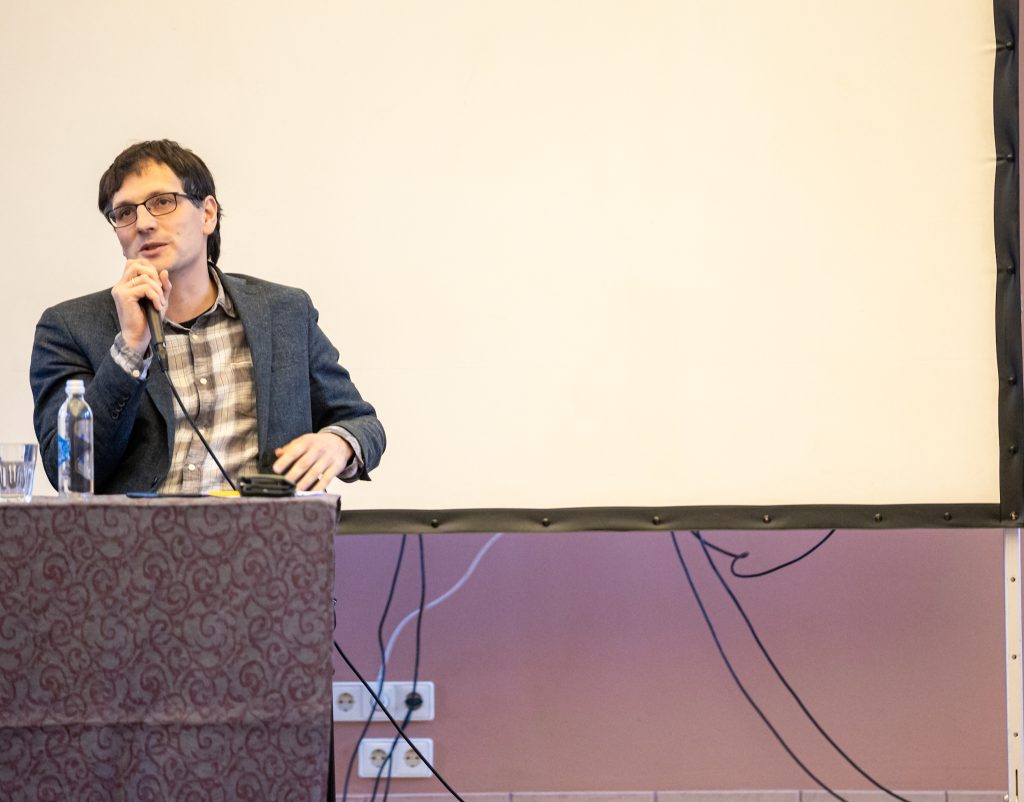Puslaidininkių tiekimo užtikrinimas Europoje (EN)
Acknowledgement
This paper is derived from a seminar on semiconductors conducted by Tom Hashimoto for the Institute of the European Right in the Summer of 2023. It is crafted for a broader audience and includes a brief industry overview, chiefly drafted by Shota Inoue. Shota Inoue, a Chief Economist and CEO at Analytica Orbis in Berlin, leads various research projects, including those organised by Japanese government institutions. Tom Hashimoto, LL.M., DPhil (Oxon), is an Associate Professor of Economics at Vilnius University and a Director at the Baltic Institute, an independent think-tank, in Vilnius. All opinions expressed herein are those of the authors and do not necessarily reflect the viewpoints of any organisations and institutions mentioned in this acknowledgement.
Abstract
This paper examines the semiconductor industry in the context of the European Chips Act, drawing lessons from the experiences of the United States, Japan, South Korea, and Taiwan. In the context of the global production of over one trillion microchips in 2020, Europe’s global market share (10 percent) reveals its vulnerability, notably in terms of its reliance on semiconductor imports which particularly affect the automotive sector. To address this, the European Chips Act proposes a significant investment of over 43 billion EUR by 2030, attracting major industry players like Intel and TSMC. Semiconductors, categorised into logic, memory, and power types, play diverse roles. Thus, the paper draws historical parallels to provide insights into sectorial and regional resilience and robustness, focusing on the rise and fall of the US-Japanese semiconductor ‘cartel’, followed by the emergence of South Korea and Taiwan. Despite facing challenges, such as supply chain disruptions and increased demand, the global semiconductor market achieved a value of 440 billion USD in 2020. In this context, the overall recommendations aim to guide EU Member States in fostering a resilient and globally competitive semiconductor industry regionally.
Introduction
This paper analyses the regional integration of the semiconductor value/supply chain, the goal of the European Chips Act, by drawing lessons from the United States, as well as three East Asian countries (i.e. Japan, South Korea, and Taiwan) that are leading the way in semiconductor-related industrial policymaking. The paper highlights what EU Member States should bear in mind when attracting and promoting the integration of their local semiconductor industries, including their supply chains. In modern industry, semiconductors are indispensable as core components for various functions such as computation, control, input/output, and conversion. According to the European Commission, over one trillion microchips were produced worldwide in 2020, with Europe contributing only about 10 percent. This share is quite disproportionate to Europe’s global GDP share. The demand for semiconductors is projected to double in size by 2030, as indicated by a study presented in August 2022. Europe’s 10 percent share became a critical issue in the first half of 2022 when a shortage of semiconductor inventories led to major delays in automobile production, a key industry in Europe. The proliferation of electric vehicles, essential for promoting the electrification of ‘mobility’ in line with the European Green Deal policy, has further increased the demand for semiconductors. Importing semiconductors, crucial core components for next-generation vehicles, from outside the region is perceived as a threat to Europe’s industrial competitiveness. Against this backdrop, on the 8th of February 2022, the European Commission presented a draft of the European Chips Act to the Member States. This proposed legislation aims to facilitate total public investment of over 43 billion EUR by 2030, with the intention to incentivise an equal investment from the private sector. The primary goal is to bolster the semiconductor value chain in Europe. Already, Intel, a US-based company, has announced a 30 billion EUR investment in Magdeburg, Germany (with Germany contributing 9.9 billion EUR) to construct a semiconductor plant. Additionally, Taiwan’s TSMC has expressed interest in investing 10 billion EUR to establish a contract manufacturing site in Dresden, also in Germany.
1. Semiconductor types, applications, and market size
Semiconductors perform essential functions in electrical circuits, including calculation, recording results, and modifying instructions through changes in electrical resistance. These functions are broadly categorised into ‘logic semiconductors’ for calculation, ‘memory semiconductors’ for recording results, and ‘power semiconductors’ for amplifying or reducing instructions. The following section offers an overview of the applications and markets for each type.
1.1 Logic semiconductors
Logic semiconductors find extensive applications in PCs, workstations, servers, and smartphones and are developed and marketed by several prominent US companies, including Intel, AMD, nVidia, and Qualcomm. These semiconductors undergo rapid performance evolution, and companies like AMD and Qualcomm are categorised as fabless since they do not operate their manufacturing departments. Instead, they outsource production to the so-called ‘foundries’, with Taiwan’s TSMC and South Korea’s Samsung increasingly dominating this sector. The ‘nanometre (nm) process’ serves as an indicator of semiconductor integration. Finer processes allow for increased circuit (transistor) density per unit area, potentially reducing costs through higher efficiency in cutting semiconductors from a single silicon wafer, essentially a thinly sliced disc. Logic semiconductors lead the current market at 7 nm and 12 nm, with the 5 nm process taking the forefront. Logic semiconductors boast the largest market share among the three semiconductor types, reaching 176 billion USD in 2022.
1.2. Memory semiconductors
Much like logic semiconductors, memory semiconductors find applications in PCs and other information equipment. However, recent advancements in process miniaturisation have enabled higher capacities, making them increasingly prevalent in auxiliary storage devices such as solid-state drives, gradually replacing hard disk drives. Unlike logic semiconductors, circuits in memory semiconductors record only On/Off switches (bits) and lack arithmetic functions, specialising in expediting the writing and reading of bits. Manufacturers such as Micron (USA), Infineon (Germany), ST Microelecrtonics (Switzerland), SK Hynix (South Korea), and KIOXIA (formerly Toshiba) (Japan) produce and market their own products. DRAM, the smallest unit of memory semiconductors, is standardised by capacity, speed (latency), and voltage and is distributed as a commodity. The memory semiconductor market was valued at 130 billion USD in 2022, making it the second largest after logic semiconductors.
1.3. Power semiconductors
Power semiconductors, unlike their counterparts, do not perform arithmetic functions or storage; instead, they specialise in amplifying, rectifying, and converting input power. Leveraging the high-speed on/off switching characteristics of semiconductors, these devices enable the replacement of power conversion methods that traditionally relied on coils with heavy iron or copper cores and rectifiers with mercury, all within a single chip. The introduction of the IGBT (Insulated Gate Bipolar Transistor) as the prevailing input signal, supplanting the GTO (Gate Turn Off) thyristor from the 1990s, facilitated this transformation. IGBT technology allows the main circuit to be switched both on and off, a capability lacking in GTO thyristors, which could only be turned on.
Power semiconductors have found widespread use in various applications, ranging from PC and smartphone chargers to the main control circuits of trains. Since the 2010s, they have been increasingly employed in high-voltage power transmission and distribution systems, passenger car powertrains, and other sectors where reliability is paramount. Despite being smaller in market size, valued at 24 billion USD compared to logic and memory semiconductors, it is anticipated to grow to 37 billion USD by 2030.
The top market share in power semiconductors is held by four companies, namely Mitsubishi Electric, Toshiba, and Fuji Electric of Japan, along with Infineon of Germany. It is worth noting the limited or absent presence of the US, South Korean, and Taiwanese companies in this market segment.
1.4. Analogue semiconductors (MEMS)
Analogue semiconductors, recognised for their ability to capture continuous data (analogue data) like temperature, light intensity, pressure, acceleration, etc., rely on changes in the electrical resistance inherent in semiconductors. These semiconductors primarily function as sensors and are occasionally termed as MEMS (Micro ElectroMechanical Systems). They encompass a wide range of devices, including laser ranging (LIDAR) and image sensors (CMOS) deployed for automated driving in vehicles, along with accelerometers and touchpads commonly found in smartphones.
In contrast to other semiconductor types, analogue semiconductors do not necessarily require miniaturisation but need to be robust enough to endure rough handling. Remarkably, the analogue semiconductor market experienced a substantial surge, reaching 74.1 billion USD in 2021, marking a rapid 30 percent growth from the previous year. Notably, market dominance is held by leading companies such as Analog Devices and Texas Instruments from the USA, alongside Sony, Rohm, and Minebea Mitsumi from Japan.
2. The formation of a Japan-US ‘cartel’ market
Looking back in history, by the early 1970s, Japan’s GDP per capita had surpassed 10,000 USD, meeting the generally accepted criteria for classification as a ‘developed country’. During this period, Japan predominantly exported automobiles and electrical appliances. To address these industries’ demands and aims for cost-effectiveness, the Ministry of International Trade and Industry (now the Ministry of Economy, Trade, and Industry) identified the domestic production of integrated circuits as a key objective. By 1974, key companies, such as Toshiba, Hitachi, Mitsubishi Electric, Sony, and NEC, collectively achieved a monthly production of 2 million chips, propelling Japan to the forefront of global semiconductor shipments.
In 1975, the Agency of Industrial Science and Technology (now the National Institute of Advanced Industrial Science and Technology) spearheaded the establishment of the Super LSI Technology Research Association, joined by Fujitsu, Hitachi, NEC, Mitsubishi Electric, and Toshiba. This association aimed to achieve pioneering technological milestones, particularly focusing on realising the then most advanced 1-micrometre process and developing 1-megabit Dynamic Random Access Memory (DRAM). The technological advancements made by this collaboration formed the cornerstone for subsequent market competition in memory and logic semiconductors, which commenced in earnest in 1979.
In 1980s, Japan secured the confidence of US computer manufacturers due to the quality, prompt delivery, and competitive pricing of its memory semiconductors, particularly DRAM, initiating an earnest effort to penetrate the US market. By 1987, Japan had secured an 80 percent share of the global market for memory semiconductors. Simultaneously, Japan concentrated on creating compatible products for logic semiconductors, achieving a 25 percent market share with the Z80, a counterpart to the i8080 developed by Intel in the US.
The tensions between the US and Japan escalated, as evidenced by the filing of a complaint by the US Trade Representative (USTR) under Section 301 of the US Trade Act (Super 301). The complaint primarily targeted Japan’s export practices involving the 64k-bit DRAM memory semiconductor and later the dumping of EPROMs, a logic semiconductor. This issue was part of a broader diplomatic concern about Japan’s trade surplus with the US. Both governments engaged in extensive negotiations lasting 13 months, from August 1985 to September 1986, resulting in the ‘US-Japan Semiconductor Agreement’. Under this agreement, the Japanese Government committed to facilitating a 25 percent market share in Japan’s semiconductor market for US companies. Additionally, Japanese companies were mandated to disclose semiconductor production costs to the US.
This agreement marked a departure from the conventional free trade norms. Japan and the US sought to control semiconductor prices by structuring a ‘cartel’, aiming to partition and monopolise the burgeoning global semiconductor market. During the process of emergence of memory and logic semiconductors, this cartel, led by Japan and the US, held sway over the semiconductor market. In response to the US-Japan market dominance, the European Community (EC) initiated its EUREKA program in 1984. This initiative led to the establishment of the Interuniversity Microelectronics Centre (IMEC) in Belgium during the same year. These early10 endeavours laid the foundation for the European Framework Programme and were seen as Europe’s strategy to counter the dominance of the US-Japan semiconductor cartel.
3. The rise of South Korean national projects
Until the early 1970s, the South Korean government viewed the semiconductor industry solely as a means of nurturing the country’s electronics sector. Joint ventures were established to perform the final assembly of semiconductors in the US, aligning with the government’s efforts to bolster the electronics industry. However, a significant shift occurred in the 1980s under the Fifth Five- Year Economic and Social Development Plan. The South Korean government encouraged major conglomerates such as Samsung, LG, and Hyundai to venture into the relatively high-risk process of wafer fabrication.
By 1986, the government took a proactive stance, offering substantial support to the semiconductor industry, particularly in the memory semiconductor sector. It guaranteed 400 USD million in long-term, low-interest loans, aiming to foster the development of memory semiconductor manufacturing technology. To encourage investment and technology transfer from the US and Japanese companies, the government relaxed capital controls on foreign investment. Previously, domestic companies were required to retain a minimum of 50 percent of the shares, but this regulation was eased to facilitate foreign investment and technology infusion.
South Korea’s strategic focus on memory semiconductors led to remarkable success, securing the top global share in memory semiconductors by 1992. This leadership in the memory semiconductor market has persisted, positioning South Korea as a dominant force to-date. The growth and advancement of the semiconductor industry in South Korea were significantly driven by robust national leadership and strategic support.
4. The outsourcing in Taiwan and the birth of ‘foundry’ business
6 Yukihito, Sato. ‘Backwardness and Innovation in the Development of Taiwan’s Semiconductor Industry’,
Ajia Keizai (a bi-monthly journal of the Institute of Asian Economic Affairs), 2016.
Although the 1986 US-Japan Semiconductor Agreement provided the US with insights into the semiconductor costs of Japanese companies, the high-cost structure of US semiconductor plants did not alleviate its disadvantage in marketing competition. The primary focus of these semiconductor plants lay in producing goods for military and aerospace applications, where pricing for public procurement was set at quite high level. Consequently, the US semiconductor industry began outsourcing older generations of logic semiconductors, which posed less risk of advanced technology outflow, to Taiwan due to its lower manufacturing costs.
Taiwan’s journey into semiconductor technology began in the mid- 1970s, with the national Industrial Technology Research Institute (ITRI) initiating a semiconductor technology accumulation project. This effort eventually led to the establishment of TSMC in 1987, which today stands as the world’s largest dedicated ‘foundry’ manufacturer. However, during its inception, TSMC possessed outdated manufacturing facilities and lacked the managerial capacity for independent development. As a result, TSMC primarily engaged in contract manufacturing (foundry business). Nonetheless, the contract manufacturing model allowed semiconductor production for multiple companies on a single process line, maintaining high facility utilisation rates.
Taiwan’s persistent commitment to the foundry business significantly reduced costs. When semiconductor miniaturisation drove up manufacturing equipment expenses in the late 1990s, major US semiconductor companies, such as AMD, transitioned to a fabless approach, creating an opportunity for Taiwan’s foundry businesses to expand further. This characteristic persisted to the present day, with Taiwan excelling in the manufacture of advanced logic semiconductors like Apple’s M-chips, Qualcomm’s SnapDragon, and AMD’s RADEON. However, Taiwan’s indigenous chip designs and developments are relatively scarce in the market. The success of Taiwan’s semiconductor industry can be primarily attributed to its focused approach and concentration on specific segments of the value chain, notably in manufacturing.
5. Commoditisation of logic and memory semiconductors
As highlighted in sections 4 and 5, the effectiveness of the semiconductor ‘cartel’ between Japan and the US diminished significantly over the 20-year period from 1980 to 2000. This decline ensued as a result of South Korea’s emergence as a strong competitor in memory semiconductors, with Taiwan excelling in logic semiconductors. Notably, the US-Japan Semiconductor Agreement, the cornerstone of this collaboration, expired in 1997, further signalling the dissolution of this once-dominant alliance.
In Japan, the substantial decline in market share for memory and logic semiconductors was sometimes labelled the ‘second defeat’ (presumably referring to 1945). This led to a consolidation of the semiconductor divisions of five or six electronics manufacturers under state-led initiatives, aiming to boost production scale and enhance research and development capabilities. However, major memory semiconductor manufacturer Elpida, a combined venture of NEC, Hitachi, and Mitsubishi Electric, filed for protection under the Corporate Reorganisation Law in 2013. Consequently, Japanese-capitalised memory semiconductor manufacturers nearly disappeared from the market. Renesas Electronics, an entity formed by merging the logic semiconductor divisions of NEC, Hitachi, and Mitsubishi Electric, sustained its operations by focusing on logic semiconductors for automobiles, a significant Japanese export. Due to the financial difficulties in the 2000s, however, Renesas was also de-facto nationalised by 2013.
Currently, Japan has largely shifted its focus away from memory and logic semiconductors towards the development and production of power semiconductors. These components regulate current and voltage, based on electrical signals, and find applications not only in electric vehicles, trains, and electrical appliances, but also in power transmission, distribution, and aerospace industries. Despite retaining a significant global market share in electricity-based applications, Japanese companies have struggled to keep pace with South Korea and Taiwan due to their integration and enclosure of end-product design and semiconductor manufacturing.
In the US, an early adoption of a value chain model involving design and development of logic semiconductors in the US, with manufacturing carried out in Taiwan, resulted in the fact that few manufacturing bases remain in the US. However, substantial value was added through patent and licensing income from design and development, contributing significantly to the US balance of trade in services to date. Furthermore, in the field of analogue semiconductors, which differ from memory and logic semiconductors, the US holds the largest global market share. These circuits convert light, sound, heat, and vibration into signals and are anticipated to expand in smartphone, IoT, and automated driving domains. Analogue semiconductors are characterised by their limited performance improvement through circuit miniaturisation and their requirement for specialised design skills when integrated into products, thus providing the US an advantage due to its proximity to end-product design and implementation.
6. Implications for the European Semiconductor Initiative
The semiconductor ‘cartel’ between Japan and the US resulted in stagnation of technological innovation post-1990 wich led to a decline in market competition. By the onset of the 21st century, South Korea and Taiwan emerged as significant players, gaining substantial market shares in memory and logic semiconductors, respectively. South Korea’s success was underpinned by its government’s deliberate focus on fostering memory semiconductor industry, whereas Taiwan excelled by creating cost competitiveness owing to the expansion of contract manufacturing scales in Japan and the USA. Japan, having ceded its market share in both memory and logic semiconductors to South Korea and Taiwan, maintained its presence in power semiconductors, leveraging effective vertical development tied to specific applications. Conversely, the US sustained its position in analogue semiconductors, an area where technological innovation and cost competitiveness held less sway. Drawing from these historical precedents, insights can be gleaned relevant for achieving the European Commission’s ‘European Chips Act’ objective of securing a 20 percent global market share by 2030.
The strategy of selection and concentration under government leadership, as observed in South Korea, poses challenges for the European Union, insofar as it may encounter difficulties in efficiently coordination its constituent Member States. Additionally, selectively investing capital in specific companies is complex from the competition law standpoint (e.g. Articles 101, 102, and 107 of the TFEU), making it a difficult approach in the EU. Consequently, the most feasible avenue for Europe lies in providing long-term, low- interest funding for high-risk processes within the value chain. Within the semiconductor domain, high-purity silicon has traditionally been the primary material for circuits. However, silicon’s physical limitations, leading to increased leakage currents since 2010, have obstructed circuit miniaturisation (i.e. higher integration). This limitation has triggered a global search for alternative semiconductor materials, with substances like silicon carbide (SiC) and gallium nitride (GaN) emerging as potential replacements for silicon. Exploring and developing new materials demands extensive research resources, time, and additional investment before mass production can occur. Europe, with its robust foundation in fundamental university research, holds a comparative advantage in terms of available research resources for this purpose.
Another effective strategy, akin to Taiwan’s approach, involves scaling up production and cost reduction through contract manufacturing, complementing the exploration of new materials. Within the US-Japan semiconductor ‘cartel’, Taiwan prioritised cost reduction to enhance profitability for both nations. However, similar cartels have organically dissipated in the 21st century. Nonetheless, Europe, like Japan and the US, commands substantial semiconductor demand. Establishing a required production scale can be achieved by initially meeting intra-regional demand through local production. However, implementation of strategies like tariff barriers and non-tariff barriers in order to acquire intra-regional market share currently faces challenges under the existing WTO regulations, let alone internal EU regulations.
Here, the evolution of Japan’s ascendancy in the power semiconductor market offers valuable insights. Japan, renowned for its technological prowess and market dominance in manufacturing electric railways, power infrastructure, and industrial machinery, pioneered the application of power conversion through semiconductor technology. This breakthrough, deemed unattainable for semiconductors until the 1990s, resulted in cost reduction and quality enhancement, consequently expanding the application scope of IGBTs (Insulated Gate Bipolar Transistors). By identifying diverse applications as primary adopters of next-generation semiconductors, semiconductor companies secured exclusive profits for a specific duration. There is a growing aspiration in the European societies to develop novel applications such as quantum computers and smart grids that cannot be achieved with the current semiconductor technology. Formulating a blueprint for semiconductors that align with the specifications required for these applications could have a profound impact. This poses challenges for countries with relatively smaller domestic demand, such as South Korea, Taiwan, and Japan, while Europe holds a comparative advantage here.
Obtaining market share in specialised niches, akin to the US approach, is conceivable as a viable path for Europe. In the US, the production of analogue semiconductors is significantly influenced by the overflow from the defence, space, and aeronautics sectors. Europe and China are other countries/regions with such industries, but there are not many others in the world. However, these niche sectors typically have a limited market size in terms of product shipments and job creation. Therefore, considering the various transaction costs, it might be more beneficial for individual countries within the region to focus on these areas independently, rather than pursuing collaborative efforts within the European Union. For instance, both the Netherlands and Germany boast substantial market shares in the realm of laser semiconductors, utilising semiconductor technology for photon emission. In medical applications, LINACs used in oscillators for heavy particle beams still rely on thyratrons, a type of vacuum tube. There are ongoing efforts to replace these with next-generation semiconductors.
Conclusion
This paper draws insights from case studies of South Korea, Taiwan, Japan, and the US, nations that have carved unique positions in the semiconductor industry, in order to offer recommendations for Europe to achieve its market share target in semiconductors. While these countries have achieved notable results within 10-15 years time-span through government and private sector initiatives, sustaining market share remains a challenge. Although attaining 20 percent share target by 2030 is a daunting task for the European Union, securing market share in specific areas by leveraging regional demand within Europe and fostering vertical development with applications seems feasible. Establishing a distinctive semiconductor industry at the Member State level is also plausible if semiconductor demand focuses on niche applications. The European Chips Act outlines a public-private investment totalling 43 billion EUR by 2030. To ensure that this investment extends beyond research and development, comprehensive measures are essential. These measures should encompass setting target specifications tailored to Europe’s strengths in specific applications.










